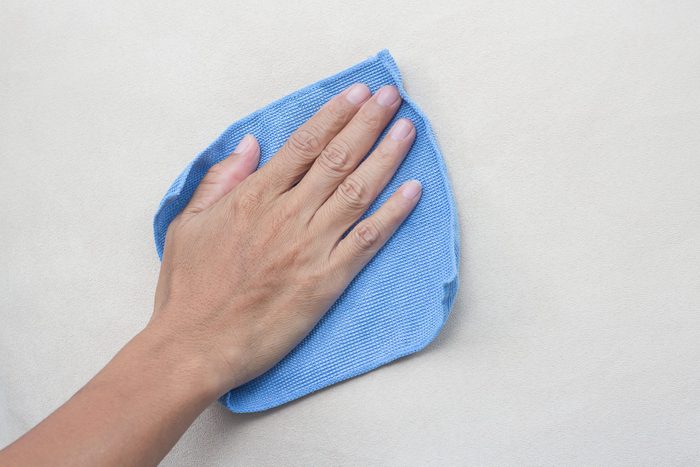Why You Should Be Cleaning Your Walls Regularly
Updated: Sep. 22, 2023

Cleaning your walls doesn't often make your to-do list. Did you know you should be cleaning your walls regularly? Here's why, and how often.
Humans built the first walls thousands of years ago, and we’ve been avoiding cleaning them ever since. Smudges around light switches? Of course. A sponge and some gentle soap, and those high-traffic spots are good as new.
But the entire wall? Who wants to do that, let alone every wall in the house? It looks high-effort and low-return. Would anyone even notice you did it?
Washing walls turns out to be a good idea, and it comes with benefits beyond a fresh, clean start. I talked with Melissa Homer, chief cleaning officer at MaidPro.com, for some advice on how to do this overlooked cleaning task.
On This Page
How Often Should You Be Washing Your Walls?
It’s a trick question because it depends on the room, says Homer.
Kitchen and bathroom walls need regular cleaning. Living areas and bedrooms can probably do with an annual wall-washing, at most. Spot cleaning keeps lesser-used guest bedrooms clean for years.
Kitchens and bathrooms need the most attention because moisture and oils in the air cause dirt to stick to vertical surfaces. “Dust that would usually fall to the floor in most rooms will stick to a wall that’s damp and sticky from cooking or shower steam,” Homer says.
Climate and personal habits affect how often you should clean your walls, too. If you have pets, or if you often keep your windows open in humid or smoggy conditions, all your home’s walls might need cleaning more frequently.
“At the end of the day, the wall will tell you if it needs to be cleaned,” says Homer.
Benefits To Cleaning Your Walls With a Mop
“Washing walls, for most people, is an aesthetic choice, as dirty walls can really take away from an otherwise attractive room,” Homer says. Dirty walls start to look discolored and uneven after being ignored, and with deep neglect can exhibit “maple-syrup” drips.
Other benefits include:
- Allergy relief: A dirty wall isn’t generally a health concern, but allergy sufferers will thank you for removing dust and other allergens.
- Extended paint life: Cleaning grimy, heavily-soiled walls can damage paint. Periodic cleaning over the life of the wall minimizes costly paint jobs.
- Preventing mold and mildew: Mold can grow anywhere, even in paint. So keep walls clean, especially in moisture-prone areas.
- Fresher look: Clean walls brighten any room and cost less than a remodel or paint.
Tools To Help Clean Walls
You don’t need much to effectively clean your walls:
- Microfiber flat mop with telescoping handle;
- Household mop bucket;
- Dishwashing liquid, such as Dawn,
- Neutral-pH floor cleaner like Mr. Clean;
- Microfiber cloth or sponge for spot cleaning.
Professional Wall Cleaning Tips
“The key to washing walls is to remember it’s just surface dust on a delicate surface,” Homer says. “So we don’t need to — and shouldn’t — risk doing anything aggressive to get it clean.”
Try these tips to gently and effectively clean your walls:
Check to see if the wall needs cleaning
There’s no sense wasting time washing a wall that’s not really dirty.
An easy way to check? Homer says take a microfiber towel and dampen it with a little dish-soap solution — a drop or two in warm water will do — and swipe the cloth over a washable wall. Let it dry, then come back to see how dirty your wall really is. If there’s a big change in the paint brightness or color where you dragged your cloth, the wall’s due for a cleaning.
Make sure your wall is washable
“If you have non-washable paint, you can’t clean it, even if you should,” says Homer. For non-washable surfaces, including wallpaper, use a vacuum cleaner with a soft brush to sweep up dirt and dust. Then spot clean as gently as you can.
Flat-finish paints are generally less washable than eggshell or satin, although some manufacturers make washable flat paints. If you don’t know if your paint is washable, test a small section where you won’t mind if it goes wrong, like behind the couch.
Use a mild cleaner when washing
If you’re cleaning a kitchen tile backsplash, you can afford to put a little elbow grease into it. But a painted wall needs more finesse than strength. A microfiber mop and a mild cleaner is all you need.
“Dish soaps like Dawn and neutral-pH floor cleaners like Mr. Clean are the go-to defaults for delicate tasks like washing walls, as they really can’t damage anything that can handle water,” Homer says.
Wash the entire wall
Start at the top and work down, says Homer. Use an extendable mop handle if you can, because if you don’t get the whole wall you risk leaving a visible line between dirty and clean sections.
If you have 20-foot ceilings, let the high reaches go or hire professional cleaners, Homer says. They’ll come with commercial-length poles or scaffolding and get every corner. Don’t risk a fall for a clean wall.
Don’t use too much water
The microfiber mop should be damp, not wet, when cleaning your walls. Squeeze out excess water before applying it to the wall. Excess water will just cause a mess, and risk damaging your baseboards and/or carpet.
Water and electricity don’t mix, so don’t allow water to get in your receptacles or light switches. It can cause a dangerous short circuit or ground fault.
